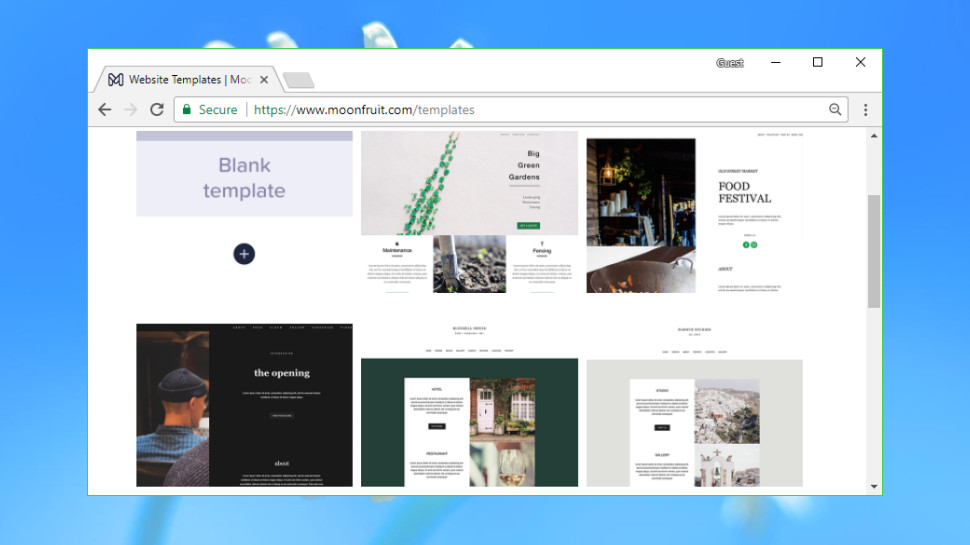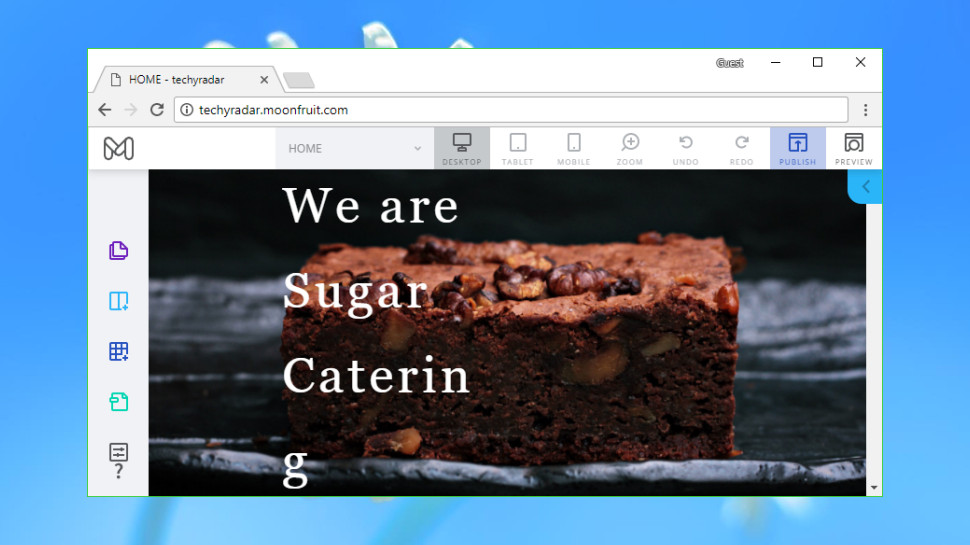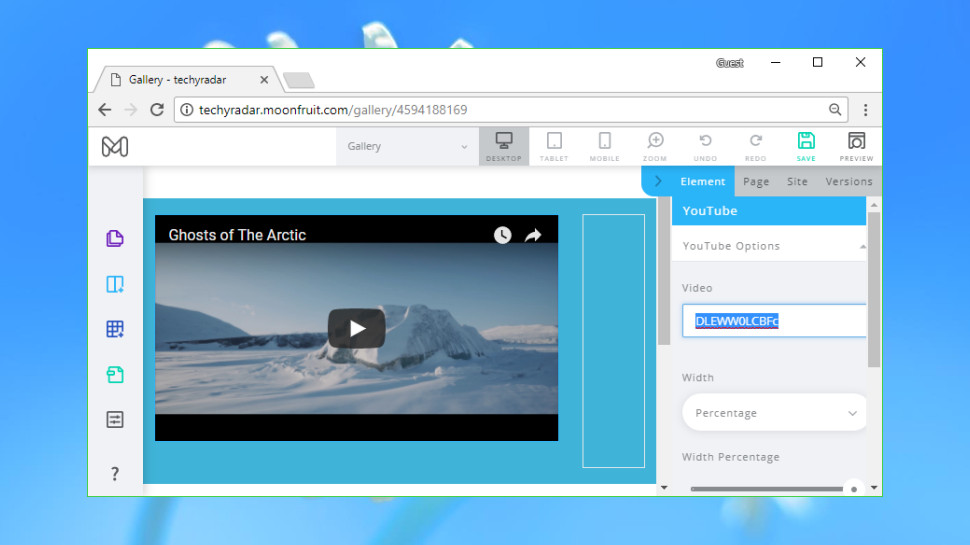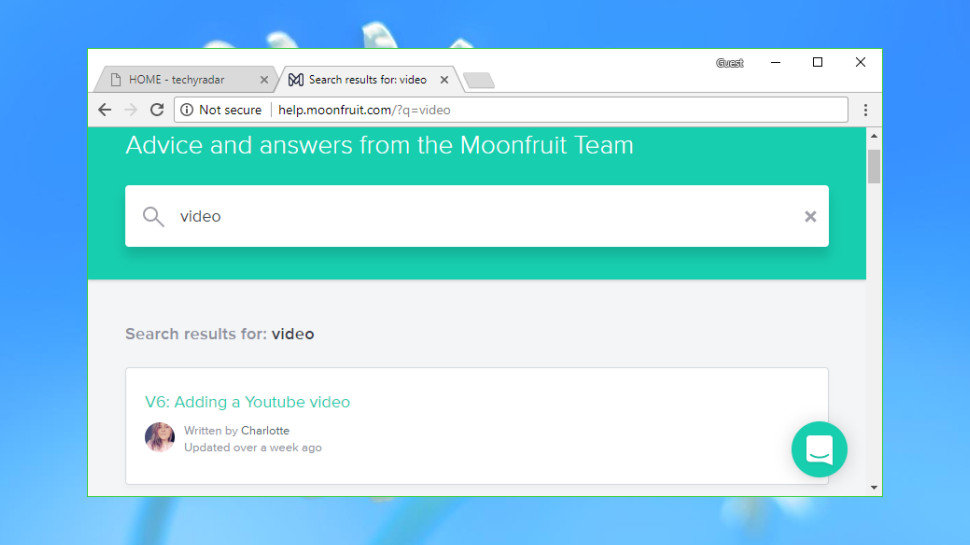Moonfruit
Launched in 2000, Moonfruit is a popular website building service now owned by British Yellow Pages publisher, Yell UK.
Options are a little more basic than some of the competition, with the company offering only a small number of responsive templates (see a preview here). Still, these can be customized by tweaking individual details or dragging and dropping full content blocks. Your pages can include image galleries, forms, maps, social feeds, embedded videos and more.
Moonfruit's Basic plan gets you a single site with 500MB of storage, but no specific page or bandwidth limits. Even though it costs £3.99 ($5) a month paid annually, this still includes Moonfruit branding.
Moonfruit's Professional plan loses the ads, fortunately. It supports up to five sites and a maximum of 10GB storage, gives you a free domain, and includes a £75 Adwords voucher. As we write, the Professional plan looks decent value at £4.49 ($5.60) a month, but this is a "limited offer". Normally it's a more average £8.99 ($11.25).
At the time of writing, neither the Basic or Professional sites support HTTPS. That's not going to look good for any professional or business sites, even if they're not planning to support any kind of secure transactions.
Two further shoprocket-powered plans – Ecommerce Lite for £14.99 ($18.75) a month, Ecommerce Pro for £19.99 ($25) – are listed as "coming soon". Both give you a configurable web store with support for unlimited items, and the Pro plan adds support for digital items.
Moonfruit offers a free 14-day trial, and even if you sign up after that, the company says it will refund your money if you cancel within 14 days. This isn't automatic – you must ask the support team via live chat – and if you've registered a domain through the plan, that cost will be deducted. But overall, the Moonfruit policy is much like any other, and you should have no difficulty getting a refund, if you need one.

Getting started
Creating your Moonfruit account is easy, and works much like most other services: enter your email, a username and password, or sign up directly using your Facebook or Google accounts. Follow up by choosing your preferred Moonfruit subdomain (yourname.moonfruit.com) and you're taken directly to the editor.
We tried this, and were taken directly to a blank editor with no obvious button or menu options for kicking off our site. Stepping back to the Site Manager revealed an Add Site button, and clicking that displayed just eight templates. The designs aren't bad, but they don't begin to cover the range of styles a user might want. If you're hoping for an instant site you can modify and use right away, there's a good chance you'll be disappointed.
Moonfruit's template preview option is poor, too. You're able to view the template pages as a static slideshow, but there's no immediate way to navigate a template site within a browser tab, or to see how it will look on a mobile. That matters, as you can't change a template if you don't like the results – you must start again.
Select a template as carefully as you can, and it opens in the editor's familiar interface. The home page is displayed in the body of the screen, while a sidebar and menu bar give you options to modify the page or preview the results. If you've used a website builder before, you'll already understand the basics – and if you're a newbie, a few minutes of pointing and clicking will get you up to speed.

Editor
Some website builders impress you immediately with their flashy visuals and depth of features. Moonfruit, well – not so much. Tiny sidebars hide away on the left and right, unintuitive low-res icons are everywhere (there are tooltips, but you'll need them), and the emphasis is very much on keeping information hidden until you request it.
Tap an image in most website builders, for instance, and a dialog appears showing you most of its key details at a glance. Do the same in Moonfruit and a right-hand sidebar displays categories only: Background, Position, Text, Outline, Animation. You need to click Text to see and edit those properties, then Position to change those, and so on. Moonfruit might argue this helps to reduce visual clutter, as you only see the information you need, but it may also force you to make more clicks to do the same amount of work.
Some basic edits are still very straightforward. Not happy with that button caption? Double-click it, type a new one, press Enter. You can edit the contents of text boxes in much the same way, including changing text styles and colors, inserting lists and adding links.
Moonfruit also adds a few useful shortcuts of its own. Clicking any page object displays a tiny toolbar with four handy functions: Copy, Duplicate, Delete, and a Help button which opens the support page for that object type. An Undo button at the top of the page recovers from any bad decisions, and you can save the project whenever you like.
An Elements button allows adding new objects to your page: text, images, galleries, buttons, video (YouTube, Vimeo), music (Spotify, SoundCloud), Google services (Maps, Search, Calendar), limited social media elements (Facebook pages, comments and likes, Twitter feeds and more), and a good range of form-related services that includes Wufoo, Google Forms and Moonfruit's own form objects.
A Sections button allows adding predefined content blocks. There are eye-catching Hero sections (an important element to highlight a key feature of the site), page bodies in various styles, navigation tools, and layout sections which organize your content in various column formats. The Section bar includes appealing thumbnail previews of all these elements, too, showing the editor can deliver some visual flair when it tries.
Moonfruit limits the customizations you can apply to many page objects. You can't manually resize, or drag-and-drop a button, for instance. The most you can do is set it to align to the left, right or center of the page, and to size it automatically, or to set the width to a percentage of the page.
But on the plus side, the editor does have many integrated ways to tweak each object. Even a simple button allows customizing text style, size, color, hover color, button shape, border style, link type and destination (new or same window), and applying a range of animations.
Whatever changes you make can be previewed at any time in desktop, tablet or mobile views. At least, that's the theory. Although this mostly worked for us, one site appeared completely blank in the mobile view. If that happens regularly (and we've no idea if it does) it could be a major hassle.
The editor does have some useful options hidden away in its Settings dialog. You're able to define a favicon (the small icon that represents your site in a browser tab) and the social preview images displayed when your site is shared on Facebook. There are also built-in options to connect your site with Google Analytics and Google Search Console, potentially giving you much more information about your website and its visibility on Google.

Media
Moonfruit's media handling abilities are much like the rest of the service – they cover the basics, but don't have quite the power or customization options you're likely to want.
Add a single image, for instance, and you can't precisely resize or position it. Image editing features are restricted to settings for brightness, contrast and saturation. Even those are only available in five preset values: 0%, 25%, 50%, 75% and 100%.
An Image Gallery control supports filmstrip, gallery and slideshow views. There are a few tweaks – enable or disable autoplay, set various arrow styles – but nothing to set your design world alight.
Video support is limited to embedding single YouTube or Vimeo clips. There's no video wall or anything more complex, although we did find one interesting option buried deep in the menus: you can set the background of any element to a stock or YouTube video.
Audio support is a little more capable, with apps to embed Spotify playlists or SoundCloud content.
Bonus options include the ability to embed Instagram and Pinterest content, as well as PhotoSnack slideshows, and an HTML Snippet option may allow you to use content from some other sites.
While this will cover simple websites, many builders give you much more. Wix can work with content from Flickr, for instance, as well as embedding PDFs and Google Docs, and presenting all of them in a much wider range of players and styles.
Moonfruit does provide a decent file manager for managing your content. Upload website images and you can organize them into folders, view them as grids or lists, and sort your media by name, size, or age (the newest first, or oldest). Files can then be added directly to images boxes or galleries without having to re-upload them every time.
The file manager also includes a Free Photos tab with some stock images, but don't get your hopes up. There are only around 220, and the quality was no more than average. We would rather have this photo set than nothing at all, but the reality is you'll get a far better choice of images from websites like Pexels.com.
Blogging and e-commerce
Moonfruit used to provide its own blogging platform, but that was in the old days with its Flash-based editor. The latest version is pure HTML5, and while that's an improvement, it also means some more advanced features, including the blog, have disappeared.
The only replacement available right now is a widget to integrate a WordPress.com blog. Essentially, you must create and manage your blog on WordPress.com (which you can do for free), and the Moonfruit widget simply displays the URL of that blog in a box on your site.
This approach works in the most basic of ways, but it doesn't look great, and not being able to manage the blog and website together could make your life more complicated. Even something as basic as coordinating the images and color schemes of both sites will take some time and thought.
At the time of writing, Moonfruit has no e-commerce solution. No, not even a PayPal button. There are two upcoming plans which will be using the shoprocket engine, though.
As we mentioned at the outset of this review, Ecommerce Lite gives you the full store with unlimited products for £14.99 ($18.75) a month, while Ecommerce Pro throws in digital goods support for £19.99 ($25). Shoprocket has a quality store, and this may well be worth a closer look, but we'll have to wait to find out.

Support
Moonfruit provides a web knowledgebase where you can search for details on any part of the service. It's always accessible from a Help icon within the editor, or you can browse it at any time from help.moonfruit.com.
One issue we quickly noticed is that the Help site wasn't using HTTPS. Why? Trying to access http://ift.tt/2DB1XLU in Microsoft Edge showed us that the certificate had an invalid name (it had been issued to intercom.help). We'll give one bonus point to Moonfruit for noticing the issue and changing the link to regular HTTP, but we'll also subtract a hundred points for not ensuring the site is properly configured in the first place. If the company can't sort this out for itself, what are the chances that it will be able to solve complicated issues for you?
We moved on to explore Moonfruit's knowledgebase, anyway. This has a reasonable number of articles, but they're generally short and lacking in detail.
Confusingly, the knowledgebase covers the same topics for both Moonfruit's old editor and the new one, so most keywords will return a lot of articles that won't help you. Worse still, the site doesn't clearly explain which is which, beginning some titles with 'V6', others with 'Responsive Editor', and hoping users will guess correctly.
('Responsive Editor' is the latest of the two, and yes, that would have been our first guess, too. But we shouldn't have to guess at all, and at the very least, all V6 articles should now have a top line explaining that they refer to the old editor, not the current one, making it clear to everyone what's going on.)
Moonfruit claims to offer live chat support, too, but there was no one available when we tried it. Our question was accepted, and we were told we would receive a reply via email instead. 24 hours later, we were still waiting. We've no idea how typical that kind of delay might be, but it does suggest support isn't going to be as responsive as you might like.
Final verdict
Moonfruit is a basic website builder which currently lags well behind the competition in terms of power, features, ease of use, support, visual appeal and just about everything else. Significant updates are coming, apparently, including a capable web store, but right now we would stay away.
- We’ve picked out the top 10 best website builders for small businesses
0 comments:
Post a Comment